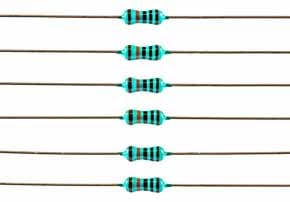Resistor Maximum Voltage
It is important to ensure that in any circuit design that the maximum voltage is not exceeded for any given resistor - there are two main elements to this.
Home » Electronic components » this page
Resistor Tutorial Includes:
Resistors overview
Carbon composition
Carbon film
Metal oxide film
Metal film
Wirewound
SMD resistor
MELF resistor
Variable resistors
Light dependent resistor
Thermistor
Varistor
Resistor colour codes
SMD resistor markings & codes
Resistor specifications
Resistor maximum voltage
Where & how to buy resistors
Standard resistor values & E series
When using a resistor in any circuit, it is important to ensure that the maximum voltage for that particular resistor is not exceeded.
Exceeding the maximum voltage can lead to problems of failures and general unreliability.

Resistor voltage limiting factors
For any resistor there are two main factors that limit the maximum voltage at which it can operate:
Resistor breakdown: The breakdown or flashover voltage is one where the resistor insulation physically breaks down and this is given in the specification for the resistor or series of resistors in the data-sheets. This can be important when the voltage across the connections is exceeded, or if the resistor case may be in contact with an earth point for some reason.
Power limitation: The power dissipation limit is not generally mentioned in the specification, apart from specifying the maximum power dissipation for the particular resistor series.
Resistor breakdown voltage
The resistor voltage breakdown occurs when the voltage from the resistor to another part of the circuit is so high that the insulation breaks down.
For some very high resistance resistors, the voltage across the ends may become sufficiently high to cause breakdown and possible flash-over.
Although it is possible to increase the voltage rating in some instances by placing two resistors in series, care must be taken to ensure that the medium onto which the resistors are connected can withstand the voltages.
Printed circuit boards and tag boards may have voltage limits, so this must be considered for the circuit to operate safely and reliably.
Maximum voltage for power dissipation
The more usual voltage limit for the resistors results from the voltage across the resistor causing current to flow and in turn power will be dissipated.
This specification is not given for each resistor in a series in a data-sheet, but instead it can be calculated for each resistor value in turn very easily.
The maximum power for the resistor will can be found from the data-sheet, or the sales literature.
It is then possible to calculate the voltage for required for this power level across the resistor of the given value.
The standard equation for calculating the power in a resistor is:
This can be manipulated to give the following equation (multiply both sides by R) and then taking the square root of both sides:
Where:
P = power level in watts
V = voltage in volts
R= resistance of resistor on ohms
Let's take an example. If a 4.7 kΩ resistor with a half watt rating is used, then the maximum voltage can be determined from the equation we saw earlier
Putting in the values we see:
In practice, it is always best to err on the cautious side and only run resistors at 60 to 70% of their maximum power, so this will considerably reduce the maximum voltage.
Increasing the voltage limit
It is possible to increase the voltage limit for a resistor by placing two resistors in series. This will double the effective maximum voltage.
An alternative method is to select a resistor with an increased power rating, and in this way the voltage rating can be increased, where the maximum voltage is limited by the power dissipation.
The resistor maximum voltage is often something that can be missed inth e design. Although it may be picked up later when calculating power dissipations, it can be useful to have a good idea of what it may be in the early design stages.
Circumstances where the flash-over or breakdown voltage is encountered do not arise too often because many circuits these days are low voltage, and in any case the power dissipation limits are normally encountered well before this.
 Written by Ian Poole .
Written by Ian Poole .
Experienced electronics engineer and author.
More Electronic Components:
Batteries
Capacitors
Connectors
ADC
DAC
Diodes
FET
Inductors
Memory types
Phototransistor
Quartz crystals
Relays
Resistors
RF connectors
Switches
Surface mount technology
Thyristor
Transformers
Transistor
Unijunction
Valves / Tubes
Return to Components menu . . .




